People who encounter this skin disease with very unpleasant symptoms for the first time want to know what psoriasis is and how to get rid of this disease.This is a disease that mainly affects the upper layer of the epidermis and its appendages: plates and nail beds, hairs.According to statistics, psoriasis affects about 4% of the world's population.Furthermore, the disease is more common at young ages: from 18 to 23 years old.
There are many diseases similar to psoriasis, so it is important to know its symptoms to choose the right treatment.

In general, you should not self-treat the disease because psoriasis develops very quickly and can cause serious complications.Visiting a dermatologist is the only right decision if you detect signs of the disease.
Species
There are many types of this skin disease.When classifying psoriasis, the nature of the rash, the severity of the disease and the location of the lesions will be taken into account.There are the following main types of psoriasis:
- Plaque psoriasis (common).This is the most common type of the disease, occurring in 85% of all patients.It is characterized by the presence of raised gray or silvery-white patches on the surface of the skin that peel easily.Psoriasis vulgaris is another name for this form of the disease.
- Guttate psoriasis.Harmful elements in this type of disease resemble drops or dots ranging in color from red to purple.
- Pustular psoriasis.The most severe form of this skin disease.It is characterized by the presence of pustules on the body - blisters filled with clear, uninfected fluid.As the disease progresses, the fluid becomes purulent.
- Psoriatic nail lesions (nail maintenance disorder).Symptoms of psoriasis in this form affect the nail plates and the area around them: the color of the nails changes, spots appear on the surface, the skin around the bed thickens, the nail plate breaks and peels.
- Joint psoriasis.The disease is characterized by inflammation of small joints.This form of psoriasis often leads to disability.
- Inverse (folded or inverted) psoriasis.The disease affects skin folds in the groin area, inner thighs, armpits and under the mammary glands (in women).
- Palmar psoriasis.With the development of this form of the disease, all the characteristic symptoms begin to appear in the feet and hands.In severe cases, the disease affects the nails and other areas of the body.
- Seborrheic psoriasis.With this form, the rash will concentrate on the head, face and back.
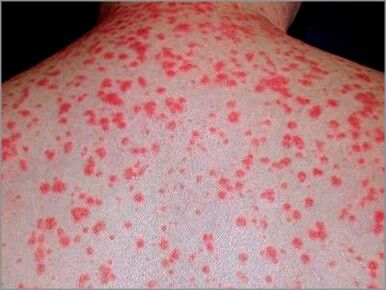
Symptoms of the disease
What does psoriasis look like?How not to confuse it with another skin disease?In the early stages of the disease, the following signs of psoriasis occur:
- the appearance on the skin of pink, red or bluish papules, located symmetrically in specific areas of the body;
- general weakness;
- chronic fatigue;
- depression or lethargy.
Gradually, the rash coalesces into plaques - forming scabs that are easily removed.The area of inflammation develops toward the edge.
At this stage of psoriasis, there are signs that can help distinguish the disease from other skin diseases.If you scrape off the scales, you can observe the phenomenon of the psoriasis triad, which is formed by the following symptoms:
- stearin stains: after scraping the plaque, silver-white scales separate, like stearin chips;
- terminal membrane: at the site of formation, there is still a very thin layer of shiny membrane, covering the papule;
- “blood mist”: at the site of the end membrane being removed, dot-like bleeding may appear, occurring due to damage to the vascular network under the skin.
Symptoms of psoriasis vary depending on the specific stage of the disease and the season.In most patients, the manifestations of psoriasis intensify in winter.The “summer” form of the disease is quite rare because the patient's condition improves under the influence of ultraviolet rays.
How does psoriasis manifest in different stages?In total there are 3 stages of development of the disease.
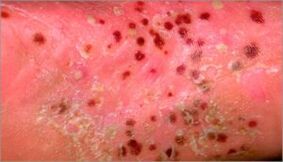
- In the advanced stage, new rashes continuously appear and existing plaques increase in size.The patient feels intense itching and the skin peels continuously.
- What does psoriasis look like in the stable stage?During this period, the growth of papules stops.Small folds are observed in the area of the plaques.Still itching intensely.
- In the regression stage, plaques begin to disappear, peeling disappears and the itching no longer torments.Pigmented areas may appear at the site of formation.
Some types of psoriasis have special symptoms.
For example, when the scalp is affected, dandruff-like patches appear first.In this case, only the skin is affected;Hair condition and growth are not affected by the disease.From the beginning, the rash spreads to the area behind the ears, neck and forehead.
The appearance of psoriasis on the palms and feet is accompanied by thickening of the skin and the appearance of cracks.In the early stages of the disease, pustules with transparent content form, which gradually become pus.Later, at the site of such formation, scars will appear, causing discomfort and pain during physical activity (working with hands, walking).In the future, the disease can spread to the back of the hand and fingers.
Nail psoriasis has the following description: first of all, the nail plate becomes covered with small indentations, reminiscent of needle marks, changes color and begins to peel.The tissue around the nail becomes thick and inflamed.
Main reason
The pathogenesis of psoriasis has not been fully studied to date.Scientists have proposed several hypotheses about why this disease occurs.There are two main causes of psoriasis.
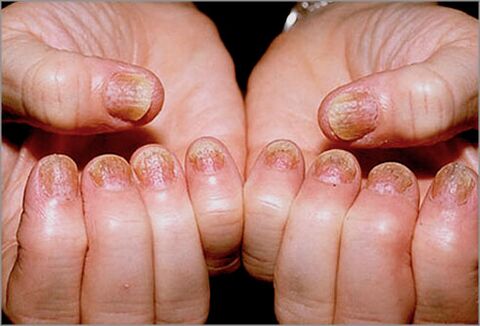
- The cause of the disease is a malfunction of the immune system.Cells designed to protect the body from bacteria and viruses penetrate the upper layer of the epidermis, where they produce substances that trigger the inflammatory process.As a result, skin cells divide rapidly and the affected area thickens.This theory is supported by a study of psoriatic plaques, which showed large accumulations of immune cells.
- Cutaneous psoriasis is caused by impaired division and maturation of epithelial cells.The result of this pathology is that diseased skin cells are attacked by immune cells.
The development of psoriasis is influenced by a number of factors.The risk of disease increases if the body is affected by several of the following conditions at the same time.
- Have dry and thin skin.Experts note that people with thick, oily, and moist skin rarely get psoriasis.This is due to the structural characteristics of the epidermis and the protective function of sebum.
- Loves excessive hygiene.Unjustified desire to constantly keep the body clean, using soap and washcloths too often will damage the skin and reduce its protective properties.
- Bad habit.When smoking and drinking alcohol, the condition of the epidermis worsens: blood circulation under the skin and tissue nutrition are disrupted.
- Negative external factors According to statistics, skin diseases often appear more often in people who are frequently exposed to detergents, household chemicals, alcohol solutions, etc.
- Medicines.Long-term use of certain medications such as antidepressants and anticonvulsants can cause symptoms of psoriasis.
- Infectious diseases.Usually, the pathology occurs immediately after an illness caused by fungi or staphylococcus.
- Climate change.It happens that to develop psoriasis, it is enough to move to a different climate.
- Skin injury.Frequently wearing uncomfortable clothes with rough seams or poor quality shoes, and the habit of scratching the same area can cause the first symptoms of psoriasis to appear.
- Emphasize.Both psychological and physical shocks (eg, prolonged hypothermia) to the body can precede the onset of the disease.
- Severe eating disorder.The course of the disease can be complicated by the abuse of sweet foods, carbonated drinks, citrus fruits, smoked meats and salty foods.
- Genetic predisposition.Can psoriasis be inherited?According to scientists, genes responsible for the functioning of the immune system are carriers of diseases.That's why the disease is transmitted from parents to children.
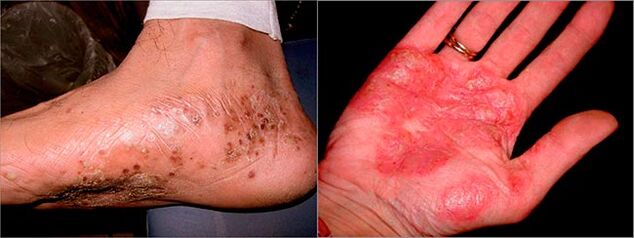
Life of psoriasis patients
Despite the fact that psoriasis is not a contagious disease and cannot be transmitted through physical contact with the patient, many patients consider themselves social outcasts, which is why they experience severe psychological discomfort.
The biggest problem is the presence of rashes on the head, ears and face. More than half of affected people constantly focus on their appearance and fear social condemnation and rejection, because psoriasis often looks like lichen.As the disease progresses, the patient limits communication with people.Only a quarter of psoriasis patients do not feel stressed about their appearance.
The disease also causes severe physical discomfort.Constant itching and burning limit the patient's ability to work, prevent proper rest, often cause insomnia, and interfere with exercise.Psoriatic arthritis adds to the symptoms of joint discomfort.
Anxiety combined with physical discomfort can cause severe depression and some patients even develop social phobia.Long and expensive treatment of the disease also negatively affects the patient, while taking away his strength and hindering his ability to integrate into society.
Why is psoriasis dangerous?
In the early stages, the disease makes the patient uncomfortable with symptoms: itching, burning, peeling.
If psoriasis is not treated, the disease will progress seriously, endangering the patient's health and even life.
In many cases, the following dangerous complications develop:
- pathological changes that occur in metabolism;
- impaired heart function, risk of stroke, myocarditis;
- there are disruptions in the functioning of the kidneys and liver;
- affected joints (usually the knuckles, elbows, knees);
- Mucous membranes affected: eyes, digestive tract, bladder;
- due to severe psoriasis, the brain and nervous system are affected;
- Potency may be weaker in men;
- As the plaque spreads throughout the skin, the skin's respiratory function and the activity of sweat and fat glands are disrupted;
- Thermoregulation is disrupted, leading to epidermoiditis, which can cause blood poisoning and subsequent death.
The consequence of more severe disease can be skin erythema.
This complication occurs in only 2% of all patients.In the early stages, it is characterized by the appearance of bright red lesions on the skin, reminiscent of a burn.Over time, scales appear on such areas and fall off in large layers.The skin in this area becomes hot and very sensitive.Other symptoms also appear: feeling of stiffness, constant itching, brittle nails, excessive hair loss, enlarged lymph nodes.
If you detect signs of psoriasis, you should immediately contact a dermatologist.The construction of the diagnosis is based on external examination of the skin and nails.Additional tests, as a rule, are not prescribed.If the patient complains of joint pain, X-rays and blood tests will be performed to rule out other types of arthritis.
Only a doctor can accurately diagnose and decide how to treat psoriasis.
Treatment methods
It should be noted right away that psoriasis cannot be completely cured.
Winston Churchill also said: “I will erect a monument made of pure gold to the person who can learn everything about psoriasis and find effective treatments for this disease.”
Prepare outside
Whatever the cause of psoriasis, your doctor will first prescribe topical treatments to help ease the uncomfortable symptoms.First, non-hormonal creams, ointments and creams containing tar, oil, zinc or medicinal herbs are used.In most cases, these drugs help to forget the unpleasant signs of psoriasis after 3-4 weeks of use.
If non-hormonal ointments are not effective, hormone-based medications for psoriasis are used.They must be used strictly as prescribed by a specialist, without exceeding the dosage or increasing the treatment course.With the help of hormonal ointments, you can quickly forget what psoriasis is, but there is a high risk of serious side effects.
Even the newest local drugs must be used in combination with other drugs.In addition to ointments, enteric sorbents are prescribed to remove toxic substances from tissues and immunosuppressants, designed to reduce the response of the immune system.Treatment is impossible without taking vitamin complexes, especially vitamins B, A, C, D.

Physical therapy
These psoriasis treatments are widely used at all stages of the disease.Procedures such as baths, phototherapy and ultraviolet light therapy provide excellent results.
New treatments for the disease include cryotherapy, electrosleep, hirudotherapy, and PUVA therapy.
In advanced forms of the disease, the use of ultraviolet rays has a beneficial effect.Thanks to this method, after only 20–30 treatments, damaged cells will be destroyed, peeling will be removed, damaged skin will be restored and the immune system will return to normal.Before the entire procedure, a test session is performed, exposing a small area of the patient's body to the rays.If the skin reaction is normal, a full course will be prescribed.In summer, patients are recommended to continue UV treatment under natural sunlight.
Traditional medicine
Folk remedies for any type of psoriasis can be used only with the consultation of a doctor.
It is important to understand that severe symptoms of psoriasis cannot be eliminated at home.
Traditional recipes only help soften peeling skin and temporarily eliminate itching.The following products receive the best reviews from patients.
Tar:
- in the first days from the onset of the disease, apply tar to the affected area with a cotton swab for 10 minutes, then wash with tar soap;
- on days 4–5, increase the duration to 40 minutes;
- The entire course of treatment is 12 days;
- It is better to use tar before going to bed because its smell will completely disappear at night.
Celandine:
- pass through a meat grinder a few bushes of celandine, uprooted;
- Squeeze the juice from the resulting mass;
- lubricate each affected area of the body with juice;
- Repeat the procedure until the external signs of the disease disappear completely.
Eggs and vinegar:
- Prepare the ointment by beating 2 eggs and 20 ml of vegetable oil;
- add 10 ml of acetic acid to the mass;
- Lubricate the rash and plaque with the resulting product every night;
- Treatment course: 3-4 weeks.
Herb:
- Grind 20g of St.John's wort, 20 g of celandine root, 10 g of marigold flowers and 10 g of propolis into a paste (better done in a clay bowl);
- add 20 ml of vegetable oil to the medicinal herbs;
- Apply the prepared product to the affected area three times a day;
- You can stop treatment as soon as signs of the disease disappear.
Elderberry infusion:
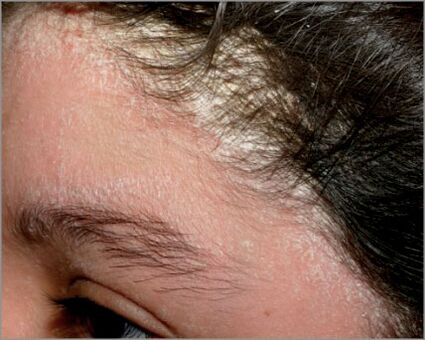
- Pour 0.5 liters of boiled water into 10 g of elderberry leaves and flowers;
- leave the infusion at room conditions for half an hour;
- drink 80 ml of infusion each time itching increases after eating;
- Course of treatment - 10 days.
Diet
No matter what psoriasis treatment is used, without following a special diet, much improvement will not be achieved.To adjust the diet, it is better to contact a specialist who will draw up a menu taking into account the individual characteristics of each particular patient.To ensure that the item "psoriasis" no longer appears in your medical history, you should know and follow the general principles of nutrition for patients.In case of this disease, the following things should be excluded from the menu:
- any type of nut;
- citrus;
- smoked meat;
- spice;
- salinity;
- spicy dishes;
- fatty foods;
- ale;
- blue cheese.
If your medical history includes a diagnosis of psoriasis, you need to make sure your diet is balanced.Every day on the dining table there must be foods that provide the body with all the necessary substances.
It is especially important to provide adequate amounts of fatty acids for all types of fish.
Recommendations for patients
To forget about any disease that has tormented you for a long time, regardless of what type of psoriasis you have, adhere to the following important rules during and after treatment:
- use gentle skin care: wash with warm water and neutral products, do not rub the body with a towel, but gently blot;
- give up regular cosmetics for a while, avoid using products that are new to you;
- When doing any household chores, wear protective gloves;
- limit exposure to allergens;
- wear clothes and shoes made of natural fabrics, without rough seams;
- Drink at least 1.5 liters of clean water every day.
You need to understand that psoriasis cannot be completely cured.However, if you choose the right method to fight this disease, you can get rid of unpleasant symptoms and achieve stable remission.
Keep your skin clean, pay attention to the slightest changes in its condition, and if you have suspicious symptoms, contact a specialist.Taking care of your own body will help you stay healthy and beautiful.To stay up to date with interesting information and current news, subscribe to our articles and remember to share them with your friends on social networks.See you again!
This article has educational, encyclopedic and informational functions only.Your doctor's approval is required before using the tips and recommendations described in this article.You should not self-medicate!


























